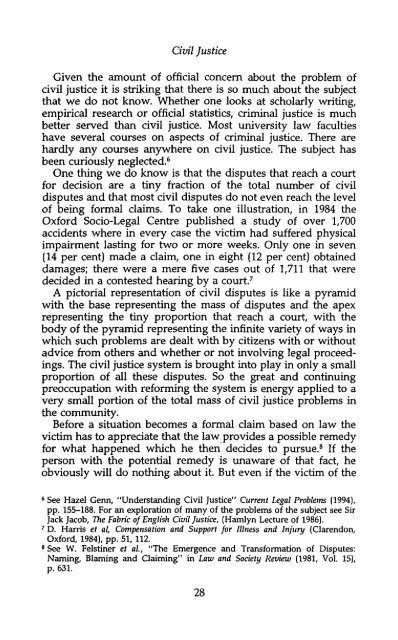HAMLYN - College of Social Sciences and International Studies ...
HAMLYN - College of Social Sciences and International Studies ...
HAMLYN - College of Social Sciences and International Studies ...
Create successful ePaper yourself
Turn your PDF publications into a flip-book with our unique Google optimized e-Paper software.
Civil Justice<br />
Given the amount <strong>of</strong> <strong>of</strong>ficial concern about the problem <strong>of</strong><br />
civil justice it is striking that there is so much about the subject<br />
that we do not know. Whether one looks at scholarly writing,<br />
empirical research or <strong>of</strong>ficial statistics, criminal justice is much<br />
better served than civil justice. Most university law faculties<br />
have several courses on aspects <strong>of</strong> criminal justice. There are<br />
hardly any courses anywhere on civil justice. The subject has<br />
been curiously neglected. 6<br />
One thing we do know is that the disputes that reach a court<br />
for decision are a tiny fraction <strong>of</strong> the total number <strong>of</strong> civil<br />
disputes <strong>and</strong> that most civil disputes do not even reach the level<br />
<strong>of</strong> being formal claims. To take one illustration, in 1984 the<br />
Oxford Socio-Legal Centre published a study <strong>of</strong> over 1,700<br />
accidents where in every case the victim had suffered physical<br />
impairment lasting for two or more weeks. Only one in seven<br />
(14 per cent) made a claim, one in eight (12 per cent) obtained<br />
damages; there were a mere five cases out <strong>of</strong> 1,711 that were<br />
decided in a contested hearing by a court. 7<br />
A pictorial representation <strong>of</strong> civil disputes is like a pyramid<br />
with the base representing the mass <strong>of</strong> disputes <strong>and</strong> the apex<br />
representing the tiny proportion that reach a court, with the<br />
body <strong>of</strong> the pyramid representing the infinite variety <strong>of</strong> ways in<br />
which such problems are dealt with by citizens with or without<br />
advice from others <strong>and</strong> whether or not involving legal proceedings.<br />
The civil justice system is brought into play in only a small<br />
proportion <strong>of</strong> all these disputes. So the great <strong>and</strong> continuing<br />
preoccupation with reforming the system is energy applied to a<br />
very small portion <strong>of</strong> the total mass <strong>of</strong> civil justice problems in<br />
the community.<br />
Before a situation becomes a formal claim based on law the<br />
victim has to appreciate that the law provides a possible remedy<br />
for what happened which he then decides to pursue. 8 If the<br />
person with the potential remedy is unaware <strong>of</strong> that fact, he<br />
obviously will do nothing about it. But even if the victim <strong>of</strong> the<br />
6 See Hazel Genn, "Underst<strong>and</strong>ing Civil Justice" Current Legal Problems (1994),<br />
pp. 155-188. For an exploration <strong>of</strong> many <strong>of</strong> the problems <strong>of</strong> the subject see Sir<br />
jack Jacob, The Fabric <strong>of</strong> English Civil Justice, (Hamlyn Lecture <strong>of</strong> 1986).<br />
7 D. Harris et at, Compensation <strong>and</strong> Support for Illness <strong>and</strong> Injury (Clarendon,<br />
Oxford, 1984), pp. 51, 112.<br />
8 See W. Felstiner et al., "The Emergence <strong>and</strong> Transformation <strong>of</strong> Disputes:<br />
Naming, Blaming <strong>and</strong> Claiming" in Law <strong>and</strong> Society Review (1981, Vol. 15),<br />
p. 631.<br />
28

















